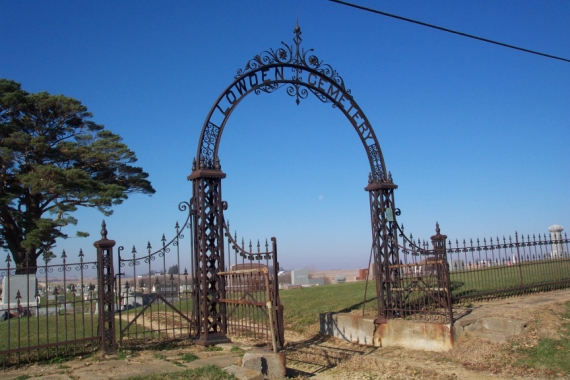Griffith Johnson was born on September 15, 1791 in Allegany County, Maryland to John Johnson and Elizabeth (Perrin) Johnson. He was a private in the 3rd Regiment of Ohio in the War of 1812. On April 22, 1813, he was married to Harriet Drake in Ohio. The couple resided in Washington, Holmes, Ohio, through at least the 1840s. The original Washington Township Land Entries have Griffith and Harriet living in Section 9, Ne160. They had seven children: Cynthia (b. 1815), Maranda (b. 1819), Matilda (b. 1819), Paul Wetherly (b. 1820), Silas (b. 1822), Timothy (b. 1824), and Elza D (b. 1826).
He spent his boyhood in Maryland and moved with his father to Harrison County, Ohio in about 1810. During the War of 1812, he was drafted into the Ohio Militia in Tuscarawas County, but at that time Tuscarawas included what later became Harrison County. He was discharged on February 8, 1812, at Fort Meigs, Ohio. About this time he went to Holmes County, where he taught school. From Stiffler’s Standard Atlas of Holmes County, page 10, an article entitled “Western Holmes County” by Joshua Crawford, we quote:
“The first school in western Holmes County was kept by Griffith Johnson in Drake’s Valley. He reisded in one end of the part log building and kept school in the other.”
Griffith taught school in Ohio for over forty years before coming out to Iowa. He was a very religious man and practiced his religion in his everyday living as well as in the schoolroom. Instead of punishing a pupil for misbehavior, he would kneel down and pray for him. He was related to the Johnson boys, John and Henry (probably cousins), who in October 1788, in Jefferson County, Ohio, were captured by the Indians and escaped by killing them.
On April 22, 1813, Griffith married Harriet Drake, daughter of David and Margaret (Hinkle) Drake, who were some of the earliest settlers in Drake’s Valley, Holmes County, Ohio, having also removed there from Maryland in 1810.
In 1824, when Holmes County was organized, Griffith Johnson was chosen as one of the first commissioners for a term of three years.
In the family Bible which he brought with him to Cedar County and which was later in the possession of another Griffith Johnson, a great-great-grandson, of Cedar Rapids, Iowa, Griffith made the following notations:
“Mother, Elizabeth Johnson, died August, 1800. Father, John Johnson, died January, 1831. My house burned February 2, 1831.”
In 1834, he was one of the subscribers to the First Church (Methodist) in Nashville. “It was to be paid in wheat delivered in Nashville, October 15, 1834. It was not for the building but for finishing the meeting house.” Griffith Johnson subscribed $3.50.
Tax lists show he owned 160 acres of land in Washington Township, Holmes County, Ohio, in 1855. In 1856, Griffith sold his farm in Ohio and with his wife Harriet and probably some of their married children and their families came to Cedar County, Iowa. Paul Johnson, their eldest son had preceded them to Cedar County in 1852.
Early Cedar County deed records indicate that Griffith purchased a farm a short distance northwest of Lowden, which was then called “Loudon” after Loudonville, Ohio. This farm was later owned by his son, Timothy E. Johnson, and later Martin Licht of Lowden.
School teachers in this new territory were scare at that time and it was not long until Griffith’s services as a teacher were enlisted by the people of the Lowden community. We quote from the Cedar County History of 1878, Page 505, as follows:
“The first school was taught by Miss Hulda Monroe, afterward by Mrs. W. S. Holton, in a building rented for that purpose in 1859. She was followed by Griffith Johnson, a veteran teacher of Ohio.” 
“Harriet Johnson, died 8, Jan. 1859, at Loudon, Cedar County, Iowa. She was born 25, Dec. 1793, in Allegany County, Md., a daughter of David and Margaret (Hinkle) Drake, who were early settlers in Drake’s Valley, Holmes County, Ohio. She married Griffith Johnson 22, Apr. 1813, and in 1856 moved to Iowa.”
The 1860 Iowa Census records show Griffith Johnson, then 68 years of age, living in the home of his son, Timothy H. Johnson, in Massillon Twp., Cedar County.
On November 13, 1864, Griffith died and is also buried in the Lowden Cemetery beside his wife. With the assistance of interested members of the Lowden American Legion Post, who were able to prove his service in the War of 1812, and secure a government headstone to be placed on his grave. This stone of white Vermont marble which measured five feet was cut in half and by using the lower half, we were able to match the lettering and place a similar stone on Harriet’s grave. This was made possible by contributions from thirty-five interested descendants. If there were headstones there at one time, they had been destroyed.
The following is a copy of Griffith’s obituary found in an issue of the Tipton Advertiser dated December 22, 1864:
“Griffith Johnson fell asleep in Jesus on Sabbath morning, November 13, 1864, at Loudon, Cedar County, Iowa, aged 73 years, 1 mo., 28 days. He was born in Maryland, September 15, 1791. At an early age he removed to Harrison, thence Holmes County, Ohio, at which place he remained until he removed to Iowa in 1856. He was a veteran of the War of 1812, joining the American Army in that year. He also professed religion the same year and united with the Methodist Episcopal Church of which he continued a consistent, active member until the time of his death, 52 years. He was indeed a pillar in the church, filling faithfully its most responsible positions, and ever exhorting, laboring and giving for the object of love. He declared ‘he would as soon as expect to get to Heaven without praying as without giving.’ He enjoyed the confidence and esteem of the entire community and was mourned by a large circle of friends. His end was perfect peace. ‘Rest, sweet Rest,’ and ‘Precious Savior’ were among his last words.
His wife Harriet preceded him in death in 1859, and a son Silas Drake Johnson was killed in the Battle of Champion’s Hill, Miss., May 16, 1863. Pastor.”



